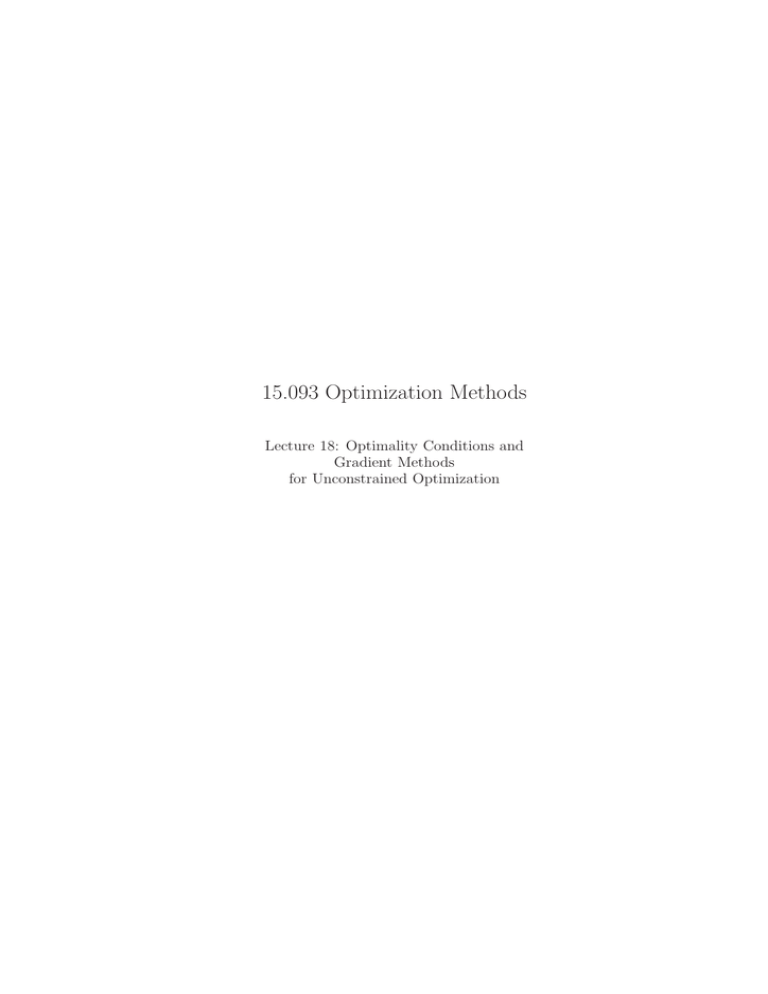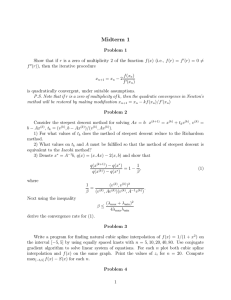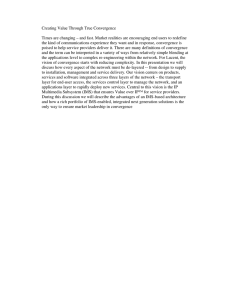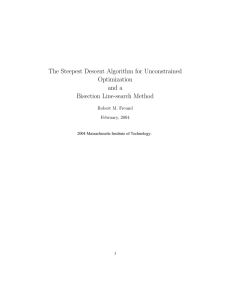Document 13449679
advertisement

15.093 Optimization Methods
Lecture 18: Optimality Conditions and
Gradient Methods
for Unconstrained Optimization
1
Outline
Slide 1
1. Necessary and sufficient optimality conditions
2. Gradient methods
3. The steepest descent algorithm
4. Rate of convergence
5. Line search algorithms
2
Optimality Conditions
Slide 2
Necessary Conds for Local Optima
“If x̄ is local optimum then x̄ must satisfy ...”
Identifies all candidates for local optima.
Sufficient Conds for Local Optima
“If x̄ satisfies ...,then x̄ must be a local optimum ”
3
Optimality Conditions
3.1
Necessary conditions
Slide 3
Consider
min f (x)
x∈ℜn
Zero first order variation along all directions
Theorem
Let f (x) be continuously differentiable.
If x∗ ∈ ℜn is a local minimum of f (x), then
∇f (x∗ ) = 0 and ∇2 f (x∗ ) PSD
3.2
Proof
Slide 4
Zero slope at local min x∗
• f (x∗ ) ≤ f (x∗ + λd) for all d ∈ ℜn , λ ∈ ℜ
1
• Pick λ > 0
0≤
f (x∗ + λd) − f (x∗ )
λ
• Take limits as λ → 0
0 ≤ ∇f (x∗ )′ d,
∀d ∈ ℜn
• Since d arbitrary, replace with −d ⇒ ∇f (x∗ ) = 0.
Slide 5
Nonnegative curvature at a local min x∗
• f (x∗ + λd) − f (x∗ ) = ∇f (x∗ )′ (λd) + 21 (λd)′ ∇2 f (x∗ )(λd) + ||λd||2 R(x∗ ; λd)
where R(x∗ ; y) → 0 as y → 0. Since ∇f (x∗ ) = 0,
1 2 ′ 2
λ d ∇ f (x∗ )d + λ2 ||d||2 R(x∗ ; λd) ⇒
2
1
f (x∗ + λd) − f (x∗ )
= d′ ∇2 f (x∗ )d + ||d||2 R(x∗ ; λd)
λ2
2
¯ < f (x̄), ∀λ
If ∇2 f (x∗ ) is not PSD, ∃d¯: d¯ ′ ∇2 f (x∗ )d¯ < 0 ⇒ f (x∗ + λd)
suff. small QED.
=
3.3
Example
Slide 6
f (x) = 12 x21 + x1 .x2 + 2x22 − 4x1 − 4x2 − x3
2
∇f (x) = (x�1 + x2 − 4, x1 + �
4x2 − 4 − 3x22 ) Candidates x∗ = (4, 0) and x̄ = (3, 1)
1
1
∇2 f (x) =
1
4
−
�
�6x2
1
1
∇2 f (x∗ ) =
1
4
PSD
Slide 7
x̄ = (3, 1) �
�
1
1
∇2 f (x̄) =
1
−2
Indefinite matrix
x∗ is the only candidate for local min
3.4
Sufficient conditions
Slide 8
Theorem f twice continuously differentiable. If ∇f (x∗ ) = 0 and ∇2 f (x) PSD
in B(x∗ , ǫ), then x∗ is a local minimum.
Proof: Taylor series expansion: For all x ∈ B(x∗ , ǫ)
f (x) = f (x∗ ) + ∇f (x∗ )′ (x − x∗ )
1
+ (x − x∗ )′ ∇2 f (x∗ + λ(x − x∗ ))(x − x∗ )
2
for some λ ∈ [0, 1]
⇒ f (x) ≥ f (x∗ )
2
3.5
Example Continued...
Slide 9
At x∗ = (4,�0), ∇f (x∗ ) = 0 �and
1
1
∇2 f (x) =
1
4 − 6x2
is PSD for x ∈ B(x∗ , ǫ)
2
2
∗
f (x) = x31 +
� x2 and ∇f�(x) = (3x1 , 2x2 ) x = (0, 0)
6x1
0
∇2 f (x) =
is not PSD in B(0, ǫ)
0
2
f (−ǫ, 0) = −ǫ3 < 0 = f (x∗ )
3.6
Characterization of convex functions
Slide 10
Slide 11
Theorem Let f (x) be continuously differentiable.
Then f (x) is convex if and only if
∇f (x)′ (x − x) ≤ f (x) − f (x)
3.7
Proof
Slide 12
By convexity
f (λx + (1 − λ)x) ≤ λf (x) + (1 − λ)f (x)
f (x + λ(x − x)) − f (x)
≤ f (x) − f (x)
λ
As λ → 0,
∇f (x)′ (x − x) ≤ f (x) − f (x)
3.8
Convex functions
Slide 13
Theorem Let f (x) be a continuously differentiable convex function. Then x∗ is
a minimum of f if and only if
∇f (x∗ ) = 0
Proof: If f convex and ∇f (x∗ ) = 0
f (x) − f (x∗ ) ≥ ∇f (x∗ )′ (x − x∗ ) = 0
3
3.9
Descent Directions
Slide 14
Interesting Observation
f diff/ble at x̄
∃d: ∇f (x̄)′ d < 0 ⇒ ∀λ > 0, suff. small, f (x̄ + λd) < f (x̄)
(d: descent direction)
3.10
Proof
Slide 15
f (x̄ + λd) = f (x̄) + λ∇f (x̄)t d + λ||d||R(x̄, λd)
where R(x̄, λd) −→λ→0 0
f (x̄ + λd) − f (x̄)
= ∇f (x̄)t d + ||d||R(x̄, λd)
λ
∇f (x̄)t d < 0, R(x̄, λd) −→λ→0 0 ⇒
∀λ > 0 suff. small f (x̄ + λd) < f (x̄). QED
4
Algorithms for unconstrained optimization
4.1
Gradient Methods-Motivation
Slide 16
• Decrease f (x) until ∇f (x∗ ) = 0
•
f (x̄ + λd) ≈ f (x̄) + λ∇f (x̄)′ d
• If ∇f (x̄)′ d < 0, then for small λ > 0,
f (x̄ + λd) < f (x̄)
5
Gradient Methods
5.1
A generic algorithm
Slide 17
• xk+1 = xk + λk dk
• If ∇f (xk ) 6= 0, direction dk satisfies:
∇f (xk )′ dk < 0
• Step-length λk > 0
• Principal example:
xk+1 = xk − λk Dk ∇f (xk )
D k positive definite symmetric matrix
4
5.2
Principal directions
Slide 18
• Steepest descent:
xk+1 = xk − λk ∇f (xk )
• Newton’s method:
xk+1 = xk − λk (∇2 f (xk ))−1 ∇f (xk )
5.3
Other directions
Slide 19
• Diagonally scaled steepest descent
D k = Diagonal approximation to (∇2 f (xk ))−1
• Modified Newton’s method
D k = Diagonal approximation to (∇2 f (x0 ))−1
• Gauss-Newton method for least squares problems f (x) = ||g(x)||2
(∇g(xk )∇g(xk )′ )−1
6
Dk =
Steepest descent
6.1
The algorithm
Slide 20
Step 0
Given x0 , set k := 0.
Step 1
dk := −∇f (xk ). If ||dk || ≤ ǫ, then stop.
Step 2
Solve minλ h(λ) := f (xk + λdk ) for the
step-length λk , perhaps chosen by an exact
or inexact line-search.
Step 3
Set xk+1 ← xk + λk dk , k ← k + 1.
Go to Step 1.
6.2
An example
Slide 21
minimize f (x1 , x2 ) = 5x21 + x22 + 4x1 x2 − 14x1 − 6x2 + 20
x∗ = (x∗1 , x∗2 )′ = (1, 1)′
f (x∗ ) = 10
Given x
dk = −∇f (xk1 , xk2 ) =
h(λ)
Slide 22
k
=
=
�
−10xk1 − 4xk2 + 14
−2xk2 − 4xk1 + 6
�
=
�
dk1
dk2
�
f (xk + λdk )
5(xk1 + λdk1 )2 + (xk2 + λdk2 )2 + 4(xk1 + λdk1 )(xk2 + λdk2 )−
−14(xk1 + λdk1 ) − 6(xk2 + λdk2 ) + 20
5
(dk1 )2 + (dk2 )2
+ (dk2 )2 + 4dk1 dk2 )
Start at x = (0, 10)′
ε = 10−6
λk =
x1k
0.000000
−2.252782
0.755548
0.204852
0.940243
0.805625
0.985392
0.952485
0.996429
0.988385
k
1
2
3
4
5
6
7
8
9
10
Slide 23
2(5(dk1 )2
x2k
10.000000
8.786963
3.200064
2.903535
1.537809
1.465322
1.131468
1.113749
1.032138
1.027806
d1k
−26.000000
1.379968
−6.355739
0.337335
−1.553670
0.082462
−0.379797
0.020158
−0.092842
0.004928
d2k
−14.000000
−2.562798
−3.422321
−0.626480
−0.836592
−0.153144
−0.204506
−0.037436
−0.049992
−0.009151
||dk ||2
29.52964612
2.91071234
7.21856659
0.71152803
1.76458951
0.17393410
0.43135657
0.04251845
0.10544577
0.01039370
λk
0.0866
2.1800
0.0866
2.1800
0.0866
2.1800
0.0866
2.1800
0.0866
2.1800
f (xk )
60.000000
22.222576
12.987827
10.730379
10.178542
10.043645
10.010669
10.002608
10.000638
10.000156
Slide 24
k
11
12
13
14
15
16
17
18
19
20
21
22
23
24
xk
1
xk
2
dk
1
dk
2
0.999127
0.997161
0.999787
0.999306
0.999948
0.999830
0.999987
0.999959
0.999997
0.999990
0.999999
0.999998
1.000000
0.999999
1.007856
1.006797
1.001920
1.001662
1.000469
1.000406
1.000115
1.000099
1.000028
1.000024
1.000007
1.000006
1.000002
1.000001
−0.022695
0.001205
−0.005548
0.000294
−0.001356
0.000072
−0.000332
0.000018
−0.000081
0.000004
−0.000020
0.000001
−0.000005
0.000000
−0.012221
−0.002237
−0.002987
−0.000547
−0.000730
−0.000134
−0.000179
−0.000033
−0.000044
−0.000008
−0.000011
−0.000002
−0.000003
−0.000000
k
||d ||2
0.02577638
0.00254076
0.00630107
0.00062109
0.00154031
0.00015183
0.00037653
0.00003711
0.00009204
0.00000907
0.00002250
0.00000222
0.00000550
0.00000054
k
λ
0.0866
2.1800
0.0866
2.1800
0.0866
2.1800
0.0866
2.1800
0.0866
2.1803
0.0866
2.1817
0.0866
0.0000
k
f (x )
10.000038
10.000009
10.000002
10.000001
10.000000
10.000000
10.000000
10.000000
10.000000
10.000000
10.000000
10.000000
10.000000
10.000000
Slide 25
5 x2+4 y2+3 x y+7 x+20
1200
1000
800
600
400
200
0
10
5
0
−5
−10
y
0
−5
−10
x
6
5
10
Slide 26
10
8
6
4
2
0
−2
−5
6.3
0
5
Important Properties
Slide 27
• f (xk+1 ) < f (xk ) < · · · < f (x0 ) (because dk are descent directions)
• Under reasonable assumptions of f (x), the sequence x0 , x1 , . . . , will have
at least one cluster point x̄
• Every cluster point x̄ will satisfy ∇f (x̄) = 0
• Implication: If f (x) is a convex function, x̄ will be an optimal solution
7
Global Convergence Result
Slide 28
Theorem:
f : Rn → R is continuously diff/ble on F = {x ∈ Rn : f (x) ≤ f (x0 )} closed,
bounded set
Every cluster point x̄ of {xk } satisfies ∇f (x̄) = 0.
7.1
Work Per Iteration
Slide 29
Two computation tasks at each iteration of steepest descent:
• Compute ∇f (xk ) (for quadratic objective functions, it takes O(n2 ) steps)
to determine dk = −∇f (xk )
7
• Perform line-search of h(λ) = f (xk + λdk )
to determine λk = arg minλ h(λ) = arg minλ f (xk + λdk )
8
Rate of convergence
of algorithms
Slide 30
Let z1 , . . . , zn , . . . → z be a convergent sequence. We say that the order of
convergence of this sequence is p∗ if
�
�
|zk+1 − z|
p∗ = sup p : lim sup
<
∞
p
k→∞ |zk − z|
Let
|zk+1 − z|
p∗
k→∞ |zk − z|
β = lim sup
The larger p∗ , the faster the convergence
8.1
Types of convergence
Slide 31
∗
1. p = 1, 0 < β < 1, then linear (or geometric) rate of convergence
2. p∗ = 1, β = 0, super-linear convergence
3. p∗ = 1, β = 1, sub-linear convergence
4. p∗ = 2, quadratic convergence
8.2
Examples
Slide 32
• zk = ak , 0 < a < 1 converges linearly to zero, β = a
k
• zk = a2 , 0 < a < 1 converges quadratically to zero
• zk =
1
k
• zk =
� �k
8.3
converges sub-linearly to zero
1
k
converges super-linearly to zero
Steepest descent
Slide 33
• zk = f (xk ), z = f (x∗ ), where x∗ = arg min f (x)
8
• Then an algorithm exhibits linear convergence if there is a constant δ < 1
such that
f (xk+1 ) − f (x∗ )
≤δ,
f (xk ) − f (x∗ )
for all k sufficiently large, where x∗ is an optimal solution.
8.3.1
Discussion
Slide 34
f (xk+1 ) − f (x∗ )
≤δ<1
f (xk ) − f (x∗ )
• If δ = 0.1, every iteration adds another digit of accuracy to the optimal
objective value.
• If δ = 0.9, every 22 iterations add another digit of accuracy to the optimal
objective value, because (0.9)22 ≈ 0.1.
9
Rate of convergence
of steepest descent
9.1
9.1.1
Quadratic Case
Theorem
Slide 35
Suppose f (x) = 12 x′ Qx − c′ x
Q is psd
λmax = largest eigenvalue of Q
λmin = smallest eigenvalues of Q
Linear Convergence Theorem: If f (x) is a quadratic function and Q is psd,
then
�
�
2
λmax
k+1
∗
f (x ) − f (x ) λmin − 1
�
≤ �
λmax
f (xk ) − f (x∗ )
+1
λmin
9.1.2
Discussion
k+1
�
∗
λmax
λmin
�
−1
2
f (x ) − f (x )
�
≤ �
λmax
f (xk ) − f (x∗ )
+1
λmin
• κ(Q) :=
λmax
λmin
is the condition number of Q
9
Slide 36
• κ(Q) ≥ 1
• κ(Q) plays an extremely important role in analyzing computation involv­
ing Q
Slide 37
f (xk+1 ) − f (x∗ )
≤
f (xk ) − f (x∗ )
κ(Q) =
λmax
λmin
�
κ(Q) − 1
κ(Q) + 1
�2
Upper Bound on
Convergence Constant δ
Number of Iterations to Reduce
the Optimality Gap by 0.10
0.0023
0.25
0.67
0.96
0.98
0.99
1
2
6
58
116
231
1.1
3.0
10.0
100.0
200.0
400.0
Slide 38
For κ(Q) ∼ O(1) converges fast.
For large κ(Q)
�
�2
κ(Q) − 1
1 2
2
∼ (1 −
) ∼1−
κ(Q) + 1
κ(Q)
κ(Q)
Therefore
(f (xk ) − f (x∗ )) ≤ (1 −
2 k
) (f (x0 ) − f (x∗ ))
κ(Q)
In k ∼ 12 κ(Q)(−lnǫ) iterations, finds xk :
(f (xk ) − f (x∗ )) ≤ ǫ(f (x0 ) − f (x∗ ))
9.2
Example 2
Slide 39
1
f (x) = x′ Qx − c′ x + 10
2
�
�
�
�
20
5
14
Q =
c=
5
1
6
κ(Q) = 30.234
�
�2
κ(Q)−1
δ = κ(Q)+1 = 0.8760
Slide 40
k
xk
1
xk
2
||dk ||2
1
2
3
4
5
6
7
8
9
10
40.000000
25.542693
26.277558
16.763512
17.247111
10.986120
11.304366
7.184142
7.393573
4.682141
−100.000000
−99.696700
−64.668130
−64.468535
−41.416980
−41.285630
−26.115894
−26.029455
−16.046575
−15.989692
286.06293014
77.69702948
188.25191488
51.13075844
123.88457127
33.64806192
81.52579489
22.14307211
53.65038732
14.57188362
10
λk
0.0506
0.4509
0.0506
0.4509
0.0506
0.4509
0.0506
0.4509
0.0506
0.4509
f (xk )
6050.000000
3981.695128
2620.587793
1724.872077
1135.420663
747.515255
492.242977
324.253734
213.703595
140.952906
f (xk ) − f (x∗ )
f (xk−1 ) − f (x∗ )
0.658079
0.658079
0.658079
0.658079
0.658079
0.658079
0.658079
0.658079
0.658079
Slide 41
k
xk
1
xk
2
||dk ||2
20
30
40
50
60
70
80
90
0.460997
−0.059980
−0.124280
−0.132216
−0.133195
−0.133316
−0.133331
−0.133333
0.948466
3.038991
3.297005
3.328850
3.332780
3.333265
3.333325
3.333332
1.79847660
0.22196980
0.02739574
0.00338121
0.00041731
0.00005151
0.00000636
0.00000078
λk
0.4509
0.4509
0.4509
0.4509
0.4509
0.4509
0.4509
0.0000
f (xk )
3.066216
0.965823
0.933828
0.933341
0.933333
0.933333
0.933333
0.933333
f (xk ) − f (x∗ )
f (xk−1 ) − f (x∗ )
0.658079
0.658079
0.658079
0.658079
0.658078
0.658025
0.654656
0.000000
Slide 42
9.3
Example 3
Slide 43
1
f (x) = x′ Qx − c′ x + 10
2
�
�
�
�
20
5
14
Q=
c=
5
16
6
κ(Q) = 1.8541
�
�2
κ(Q) − 1
δ=
= 0.0896
κ(Q) + 1
Slide 44
k
xk
1
x2k
||dk ||2
1
2
3
4
5
6
7
8
9
10
11
12
13
14
15
40.000000
19.867118
2.513241
1.563658
0.745149
0.700361
0.661755
0.659643
0.657822
0.657722
0.657636
0.657632
0.657628
0.657627
0.657627
−100.000000
−1.025060
−4.555081
0.113150
−0.053347
0.166834
0.158981
0.169366
0.168996
0.169486
0.169468
0.169491
0.169490
0.169492
0.169491
1434.79336491
385.96252652
67.67315150
18.20422450
3.19185713
0.85861649
0.15054644
0.04049732
0.00710064
0.00191009
0.00033491
0.00009009
0.00001580
0.00000425
0.00000075
λk
0.0704
0.0459
0.0704
0.0459
0.0704
0.0459
0.0704
0.0459
0.0704
0.0459
0.0704
0.0459
0.0704
0.0459
0.0000
f (xk )
76050.000000
3591.615327
174.058930
12.867208
5.264475
4.905886
4.888973
4.888175
4.888137
4.888136
4.888136
4.888136
4.888136
4.888136
4.888136
f (xk ) − f (x∗ )
f (xk−1 ) − f (x∗ )
0.047166
0.047166
0.047166
0.047166
0.047166
0.047166
0.047166
0.047166
0.047166
0.047166
0.047161
0.047068
0.045002
0.000000
Slide 45
11
9.4
Empirical behavior
Slide 46
• The convergence constant bound is not just theoretical. It is typically
experienced in practice.
• Analysis is due to Leonid Kantorovich, who won the Nobel Memorial
Prize in Economic Science in 1975 for his contributions to optimization
and economic planning.
Slide 47
• What about non-quadratic functions?
– Suppose x∗ = arg minx f (x)
– ∇2 f (x∗ ) is the Hessian of f (x) at x = x∗
– Rate of convergence will depend on κ(∇2 f (x∗ ))
10
Summary
Slide 48
1. Optimality Conditions
2. The steepest descent algorithm - Convergence
3. Rate of convergence of Steepest Descent
12
MIT OpenCourseWare
http://ocw.mit.edu
15.093J / 6.255J Optimization Methods
Fall 2009
For information about citing these materials or our Terms of Use, visit: http://ocw.mit.edu/terms.








